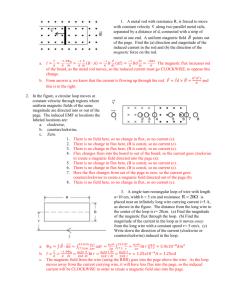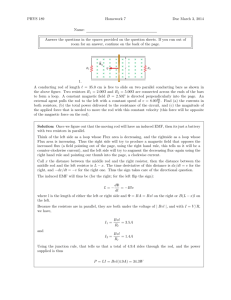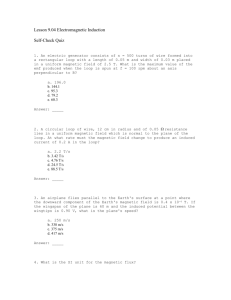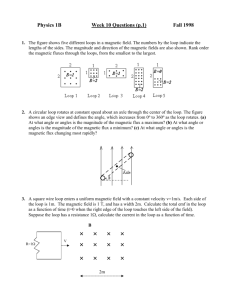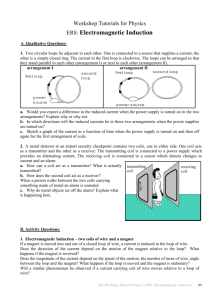Solution Derivations for Capa #10
advertisement
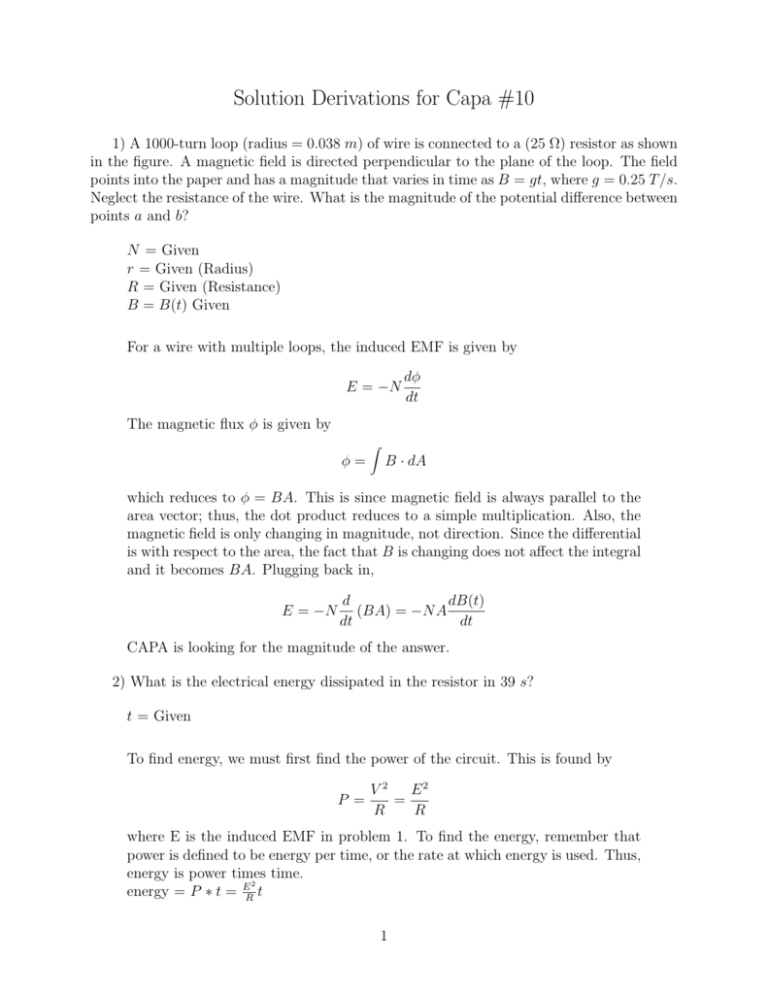
Solution Derivations for Capa #10 1) A 1000-turn loop (radius = 0.038 m) of wire is connected to a (25 Ω) resistor as shown in the figure. A magnetic field is directed perpendicular to the plane of the loop. The field points into the paper and has a magnitude that varies in time as B = gt, where g = 0.25 T /s. Neglect the resistance of the wire. What is the magnitude of the potential difference between points a and b? N = Given r = Given (Radius) R = Given (Resistance) B = B(t) Given For a wire with multiple loops, the induced EMF is given by E = −N dφ dt The magnetic flux φ is given by φ= Z B · dA which reduces to φ = BA. This is since magnetic field is always parallel to the area vector; thus, the dot product reduces to a simple multiplication. Also, the magnetic field is only changing in magnitude, not direction. Since the differential is with respect to the area, the fact that B is changing does not affect the integral and it becomes BA. Plugging back in, E = −N d dB(t) (BA) = −N A dt dt CAPA is looking for the magnitude of the answer. 2) What is the electrical energy dissipated in the resistor in 39 s? t = Given To find energy, we must first find the power of the circuit. This is found by P = V2 E2 = R R where E is the induced EMF in problem 1. To find the energy, remember that power is defined to be energy per time, or the rate at which energy is used. Thus, energy is power times time. 2 energy = P ∗ t = ER t 1 3) A conducting rod is pulled horizontally with constant force F = 4.20 N along a set of rails separated by d = 0.420 m. A uniform magnetic field B = 0.500 T is directed into the page. There is no friction between the rod and the rails, and the rod moves with constant velocity v = 3.70 m/s. Calculate the induced emf around the loop in the figure, due to Faraday’s Law and the changing flux. Assign clockwise to be the positive direction for emf. F = Given d = Given B = Given v = Given We know that E=− and φ= Z dφ dt B · dA = Z B dA since the two vectors are parallel. Since B is constant, this again reduces to BA. This time the differential is changing. However, since everything else in R the integrand was constant, dA is A regardless whether A is changing. But this value of A is the area at that instant the integral was taken. Since we are not concerned about the area at any particular instant, this does not matter. Plugging this back in, d dA E = − (BA) = −B dt dt since B is constant. The area of the loop at any time is given by length times width, or A = d ∗ x. However, the length changes with time at a rate given by v. Since the velocity is the change in length per time, the length at time t is given by x = vt. Thus, we know that A = dvt. E = −B dA d = −B (dvt) = −Bdv dt dt Depending on which direction was assigned to be a positive current and which way the rod was moving, a negative sign might be in the v. When in doubt, use the sign given by the right hand rule. 4) The emf around the loop causes a current to flow. What is that current given that the rod moves with constant velocity? (Again, clockwise is positive.) The force on a rod is given by F = IL × B = ILB since the vectors are perpendicular. This force is the applied force to the rod. The magnetic field is, of course, pulling back with an equal force since the rod is travelling at a uniform velocity. Solving for the current, I= F LB 2 Use the right hand rule for the sign of the current. 5) From your previous results, what must be the electrical resistance of the loop? (The resistance of the rails is negligible compared to the resistance of the rod, so the resistance of the loop is constant.) Use the units of ”Ohm”. From Ohm’s law, V = IR V R = I using the induced EMF and the current previously calculated. 6) The rate at which the external force does mechanical work must be equal to the rate at which energy is dissipated in the circuit. What is the rate of energy dissipation (power dissipated)? The rate of energy dissipation is another name for power. We know the equation for power is P = IV. 7) The figures below show two different situations where a current may be induced in a loop by Faraday’s Law, with the direction determined by Lenz’ Law. The magnetic field is shown by the x’s in Fig. 2. Select all correct answers in alphabetical order (e.g. AB, CEF, etc) for the current in the loop. (The compass directions are defined in the usual way: North is up, East is right, etc.) QUESTION: A) fig2: Loop moving North, induced current ‘b’. B) fig2: Loop moving South, no induced current. C) fig2: Loop moving East, induced current ‘b’. D) fig1: Magnet moving East, induced current ‘a’. E) fig1: Magnet moving West, induced current ‘a’. F) fig1: Loop moving West, induced current ‘a’. ANSWER: A) False, since the flux is not changing through the loop, there is no induced current. B) True, see (A) C) True, since the loop is moving into a region of lesser magnetic field, the induced current will be such as to oppose that change; that is, to increase the flux. Using the right hand rule, the current will flow in the direction indicated by ’b’. D) True, if the magnet is moving east, less flux will travel through the loop. Thus, the induced current will be such as to gain flux. Using the right hand rule, more flux will be in the loop if current travels in the direction indicated by ’a’. 3 E) False, see (D). F) True, if the loop moves west, the same principle as the magnet moving east applies. See (D). CAPA is looking for the answer in the form BCDF. 8) A rectangular loop with sides of length a = 1.00 cm and b = 3.20 cm is placed near a wire that carries a current that varies as a function of time: i(t) = 3.86 + 1.01t2 where the current is in Amperes and the time is in seconds. The distance from the straight wire to the closest side of the loop is d = 0.450 cm. What is the magnetic flux through the loop at time t = 1.10 seconds? (Define positive flux into the page.) a = Given in cm b = Given in cm I = i(t) = Given d = Given t = Given To start this problem, remember the flux is given by φ= Z B · dA 4 Since the area vector is in the same direction as the magnetic field, this reduces to Z φ = BdA The magnetic field due to a long wire of current is B= µ0 I 2πr Travelling a straight line along the longer length of the loop (side b), the magnetic field is constant. Thus, we will integrate all the long rectangles along side a. The small portion of the total area of these rectangles is dA = b dr. The radius in this case starts at a distance d and goes to a total distance d + a. Plugging this back in, Z Z d+a µ0 I φ = B dA = b dr 2πr d It does not matter that the current changes with time since the differential is with respect to r. Thus, everything but r is constant (that is, does not depend on r). φ = = = = µ0 I Z d+a dr b 2π d r d+a µ0 I b (ln r) 2π r=d µ0 I b (ln (d + a) − ln(d)) 2π ! µ0 I d+a b ln 2π d where I = i(t) 9) What is the induced e.m.f. in the loop at time t = 1.10 seconds? (Note that positive emf is clockwise.) t = Given The induced EMF is given by E=− dφ dt where φ was just calculated. !! d µ0 I d+a E = − b ln dt 2π d ! µ0 d+a dI = − b ln ∗ 2π d dt since the only variable dependent on t is the current I. Use the right hand rule to get the sign (and direction) correct. 5 10) A thin square coil has 39 turns of conducting wire. It is rotating with constant angular velocity in a uniform magnetic field B of 0.240 T esla. At times there is NO magnetic flux through the coil, and at other times, there is the maximum possible flux. The graph below shows the magnetic flux Φ through one turn of the coil as a function of time. What is the length of a side of the coil. N = Given B = Given Starting with the equation φ= Z B · dA There will be maximum flux when the loop is perpendicular to the magnetic field; that is, when the area vector is parallel to the magnetic field. In this case, the dot product reduces to multiplication and since both the magnetic field and area are constant, simply come out of the integral. Thus, φ = BA The area of a loop of side l is l2 . Thus, φ = Bl2 The length of a side is then s φ B The flux in the equation is the maximum flux from the graph. l= 11) Calculate the angular velocity of the coil. Use units of “rad/s”. Either from looking up the equation or knowing that velocity is distance per time, we come up with the equation ω= 2π T The period, T , of the graph is the time for one complete cycle. 12) Evaluate the magnitude of the induced voltage in the coil, Vemf , at time t = 1.70 seconds. One way to do this problem is to note that E = −N dφ dt for a multiple turn loop of wire. Thus, multiply the slope of the graph at the time given by the number of turns in the loop. CAPA is looking for a magnitude. 6 Another way is to use the equation given on the bottom of page 792 of the book. The derivation is given in the book. It is E = 2πN f Bs2 sin (2πf t) where f is the frequency which the loop oscillates f = T1 and s2 is the area of the loop (A = l2 ). The part involving the sine does not matter since it is the maximum value which is wanted. Thus, E= 1 2πN Bl2 T 13) Now connect the ends of the wire together to make a circuit. The electrical resistance of the coil is 4.62 Ω. Calculate the power dissipated at time t = 1.70 sec. R = Given t = Given Using the equation for power V2 R It is best to use the answer CAPA gives you for #12 as the V in this problem. P = 14) A very long solenoid of circular cross section with radius a = 3.20 cm has n = 85.0 turns/cm of wire. An electron is sitting just outside the solenoid, at a distance r = 3.70 cm from the solenoid axis. What is the magnitude of the force on the electron while the current in the solenoid is ramped up at a rate of 36.0 Amps/s? a = Given in cm n = Given r = Given dI = Given dt Example 31-9 on page 799 of the book explains this problem well. With Faraday’s law, we can relate the electric field to the change of the enclosed flux. That is, I E · dl = − dφ dt If we choose a circular loop a radius a away from the axis to integrate over, then the electric field will be parallel to the small piece of the loop. Since the electric field will be constant at a given distance, I E · dl = I E ∗ dl = El = 2πaE The flux is given by φ = BA 7 Thus, I dφ dt d 2πaE = − (BA) dt dB = −A dt dB = −πa2 dt E · dl = − The area of the loop we chose is A = πa2 . To find B, we know for a solenoid that the magnetic field is given by B = µ0 nI However, we don’t know B but we do know dB : dt dB dI = µ0 ∗ n ∗ dt dt Plugging everything back in, 2πaE = −πa2 dB dI = −πa2 ∗ µ0 ∗ n ∗ dt dt Solving for E, 1 dI E = − a ∗ µ0 ∗ n ∗ 2 dt The force on a charge due to an electric field E is given by F = qE. 15) A square loop of wire with a small resistance is moved with constant speed from a field free region into a region of uniform B field (B is constant in time) and then back into a field free region to the left. The self inductance of loop is negligible. QUESTION: A) When leaving the field the coil experiences a magnetic force to the left. B) While the loop is entirely in the field, the emf in the loop is zero. C) When entering the field the coil experiences a magnetic force to the right. 8 D) Upon leaving the field, a clockwise current flows in the loop. E) Upon entering the field, a clockwise current flows in the loop. ANSWER: A) False, when the loop is moving out of the field, the left hand side will be out of the magnetic field so no force will be on it. The current will be moving clockwise to counter the decrease in flux. The force on the top and bottom portions of the loop will cancel. The only remaining part is the right hand side. F = IL × B gives the force as pointing to the right. This can also be deduced by realizing that you must do work to pull the loop out of the field. Thus, a force must be pulling the loop into the field. B) True, there is no changing flux, so there is no induced EMF. C) True, basically the reverse of (A). The current will travel counterclockwise to counter the increase in flux. The only portion of the loop in the field that matters is the left hand side which will produce a force to the right. D) True, see (A) E) False, see (C) CAPA is looking for an answer in the form BCD 16) The sketches below show a circular coil and a permanent magnet; the arrows indicate both the magnitude and the direction of the velocities of the magnet and coil. In which situations will the induced voltage (and hence the current) in the loop be zero? Note that in some cases the axis of the loop is perpendicular to the axis of the magnet, in some cases it is parallel. (Enter your answer in alphabetical order.) ANSWER: A) True, since the area vector is perpendicular to the magnetic field, there is no flux in the loop. B) False, this movement will cause a decrease in flux in the loop, causing an induced voltage. C) False, this movement is the same as (B). D) True, when both the loop and magnet are moved, there is no change in flux in the loop and no induced voltage. E) False, either one of these motions will cause a decrease in flux and together they produced a greater decrease. F) False, this will cause a great increase in flux. G) True, if neither object is moving, there is no change in flux. CAPA is looking for an answer in the form ADG. 9 10




